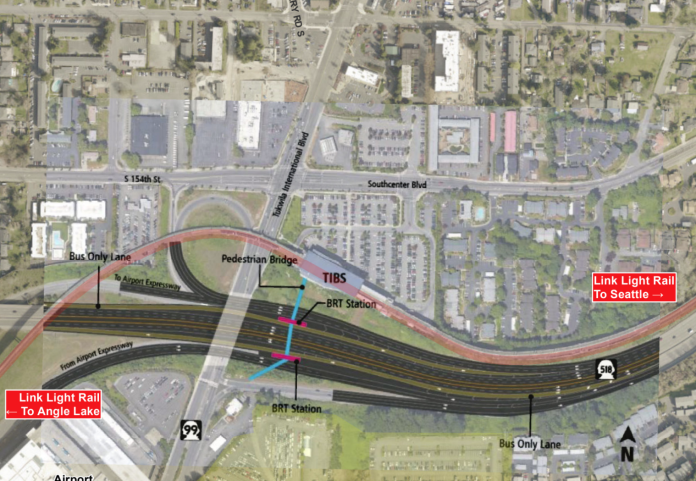
The federal programs are aimed at repairing past harms from transportation infrastructure, but the two long-planned Stride stations leave much unrepaired.
Sound Transit has been awarded a $68.9 million dollar grant by the US Department of Transportation (USDOT) to fund completion of two planned stations in Tukwila and Renton as part of its I-405 Stride bus rapid transit (BRT) project. The funds were awarded under the Neighborhood Access and Equity program, part of USDOT’s broader Reconnecting Communities and Neighborhoods program.
The award was the sole construction grant handed out anywhere in Washington State as part of this year’s round of $3.3 billion in funding, announced last week. The Reconnecting Communities and Neighborhoods program, created under 2021’s Infrastructure Investment and Jobs Act (IIJA), is intended to fund projects that repair harms created by existing transportation infrastructure, including highways.
Yet Sound Transit’s project differs significantly from most of the others funded in that the two bus stations, crucial stops as part of the overall Stride S1 Line, would almost certainly have been built without the aid of these federal dollars, and have been moving forward (and falling four years behind schedule) since voters approved Sound Transit 3 in 2016.
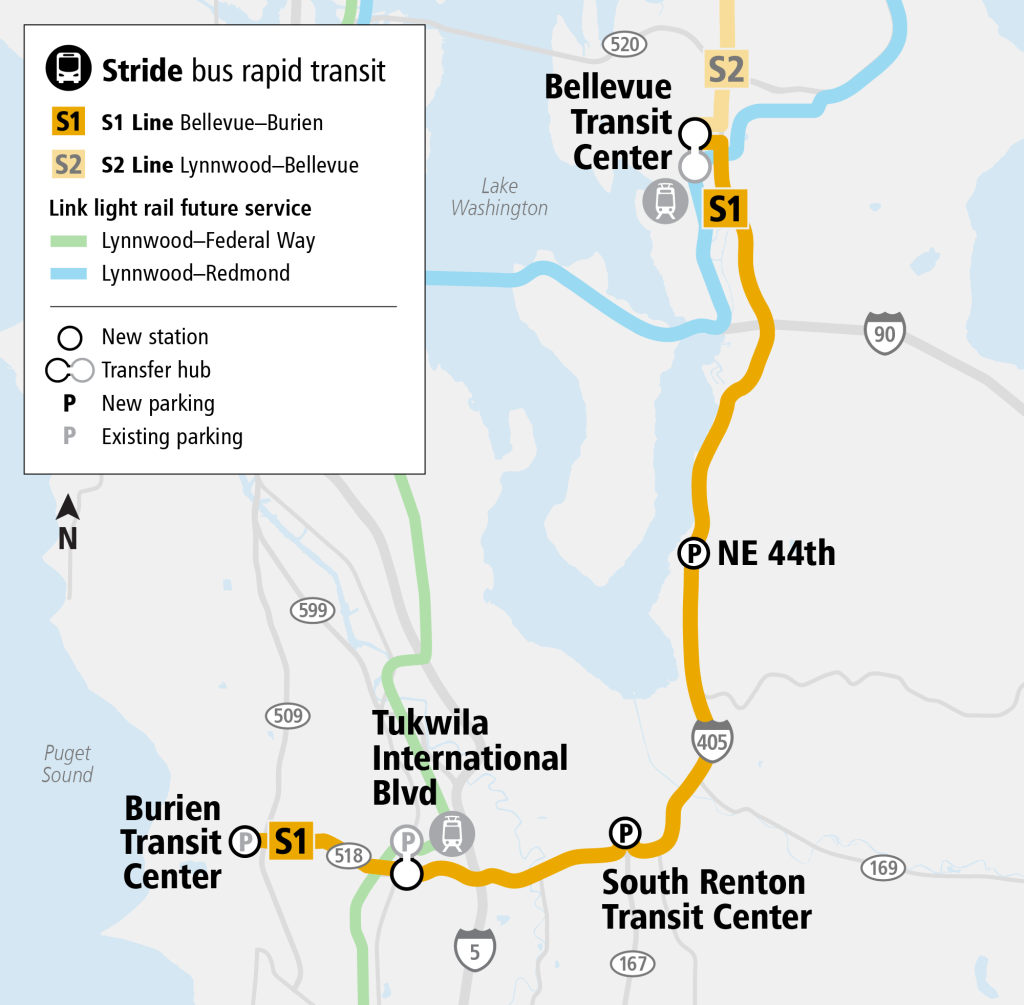
With projects aimed at repairing harms in historically underinvested communities, $69 million could be a transformative amount of money if spent well. But the funding only accounts for about 5% of the current cost estimates for the $1.25 billion overall I-405 project, which will connect Burien and Lynnwood, with separate lines north and south of Downtown Bellevue, which will serve as the transfer point. A new bus base in Bothell, a separate project required to operate the Stride lines, is expected to cost $350 million.
The overall Reconnecting Communities and Neighborhoods program has come under criticism for mostly funding projects that act as band-aids, not ones that are truly reparative. This is probably most epitomized by the award of $105 million to the City of Austin, Texas, to fund a cap on I-35, which the Texas Department of Transportation is planning to expand from 12 to 21 lanes.

With just two of the projects in this year’s round of funding — both in New York state, in New Rochelle and Syracuse — actually including a reduction in roadway capacity, the actual repair work funded here seems fairly minimal. An analysis conducted by Ben Crowther at America Walks found that 38% of the $3.3 billion — over $1.2 billion – went to highway mitigation projects. That’s just one segment of the overall 25% of IIJA spending that Transportation for America estimates has been spent overall on expanding highways.
South Renton station
In Renton, Sound Transit has already started preliminary work on its new BRT station and transit center, at S Grady Way and Rainier Avenue S, which acts as State Route 167 along that stretch. The spot is immediately across the street from the existing South Renton Park and Ride, which is operated by King County Metro and envisioned to transition to other uses once the station is open. Metro is currently set to provide around $50 million of its own funding for elements that the agency will be using at the new station, including layover and support facilities for operators. Sound Transit plans to open the station in late 2028, but it could open earlier, serving Metro buses as early as 2027.
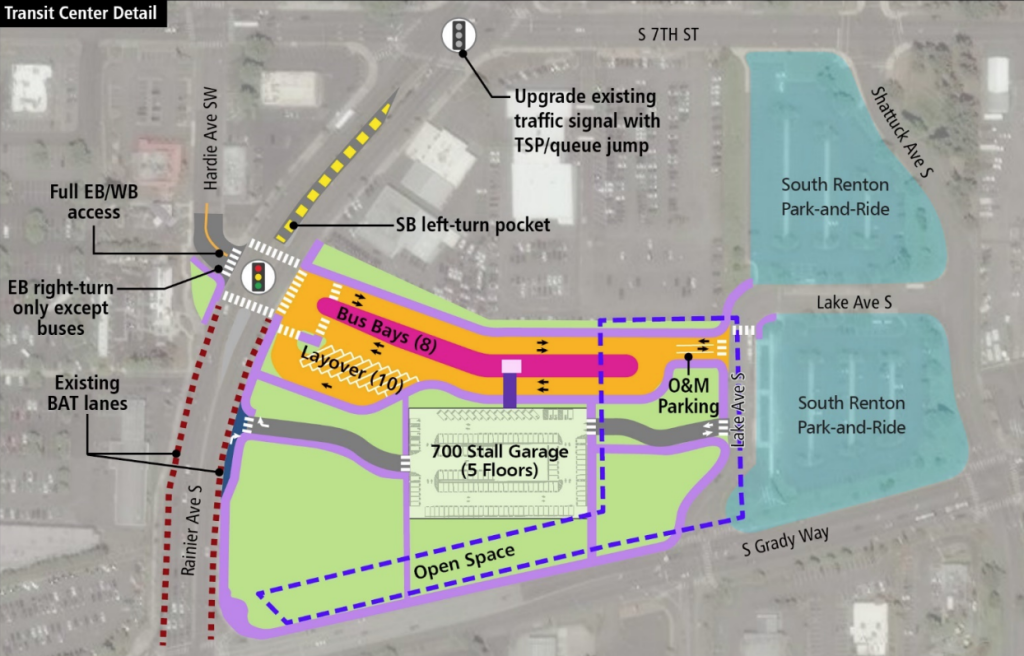
A 700-stall parking garage is planned as part of the South Renton Stride station, but shortfalls in Sound Transit’s overall financial plan have led to its construction being postponed, and it’s currently scheduled to open no earlier than 2034. Garages at NE 44th Street in Renton and at Kingsgate in Kirkland have also been deferred to around the same time. This may ultimately end up being a blessing given the fact that the last thing the Rainier/Grady Junction area needs is more parking, with some time for the agency to reassess spending transit dollars on parking down the line.
The City of Renton is working on a development plan for the broader Rainier/Grady Junction neighborhood, which currently consists mostly of surface parking lots and one-story retail buildings along wide arterial streets. But as part of the station construction project itself, now partially funded via this new grant, Sound Transit won’t be constructing any infrastructure that lessens the impact of having a new transit center wedged in between three state highways, including I-405 a few hundred feet away.
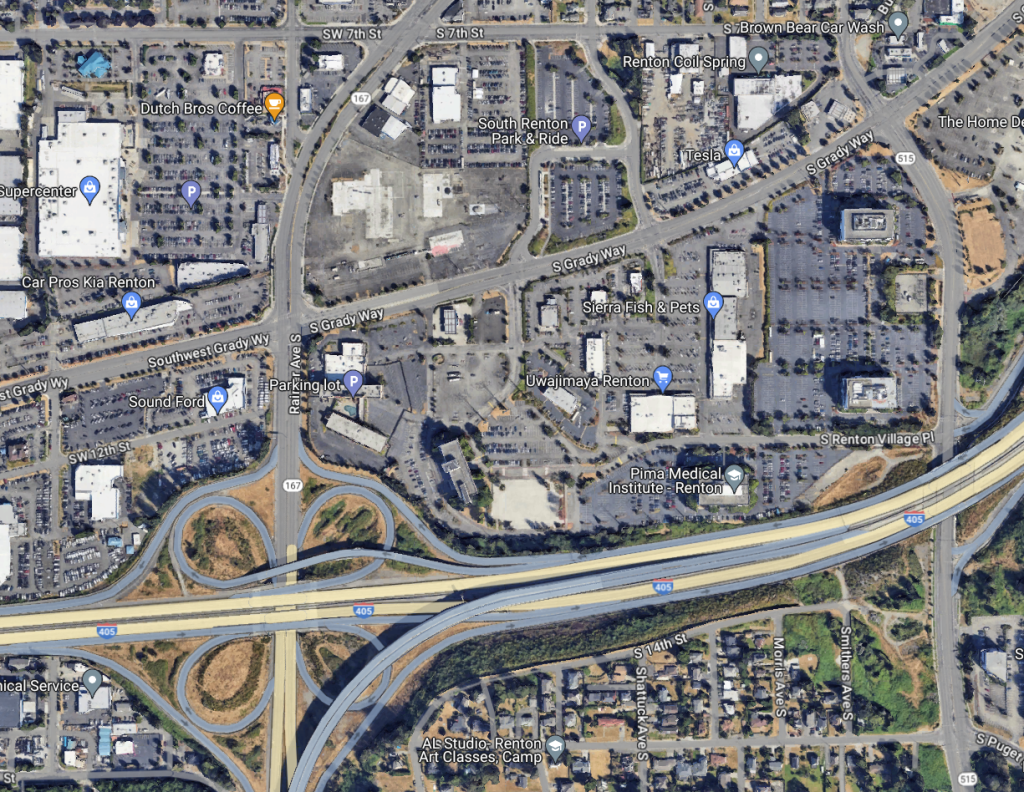
Investments that mitigate the impacts of the existing highway and highway-style infrastructure in this area will take a lot of resources, with only a few projects in the area currently planned by the City of Renton. The City does plan some improvements of its own that will make it easier for buses to access the transit station, and has started work on a planned bike connection along S 7th Street which will provide better multimodal access to the future station.
But no substantive improvements are planned that would start to actually mitigate the impact of siting a new transit center at this spot, and Sound Transit’s project, despite these federal dollars, doesn’t have that scope. The City of Renton has started talking about a potential pedestrian overpass connecting across Grady Way, which would be an incredibly expensive way to avoid having to change anything about how the street operates. If there’s restorative work happening, it’s not here.
Tukwila International Boulevard station
The Tukwila International Boulevard Stride station (TIBS), to be built immediately adjacent to the existing Link light rail station in Tukwila, will be constructed directly adjacent to the State Route 518 ramps, with passengers boarding and alighting from buses between the highway lanes. Pedestrian bridges will be the only way riders are able to leave the station.
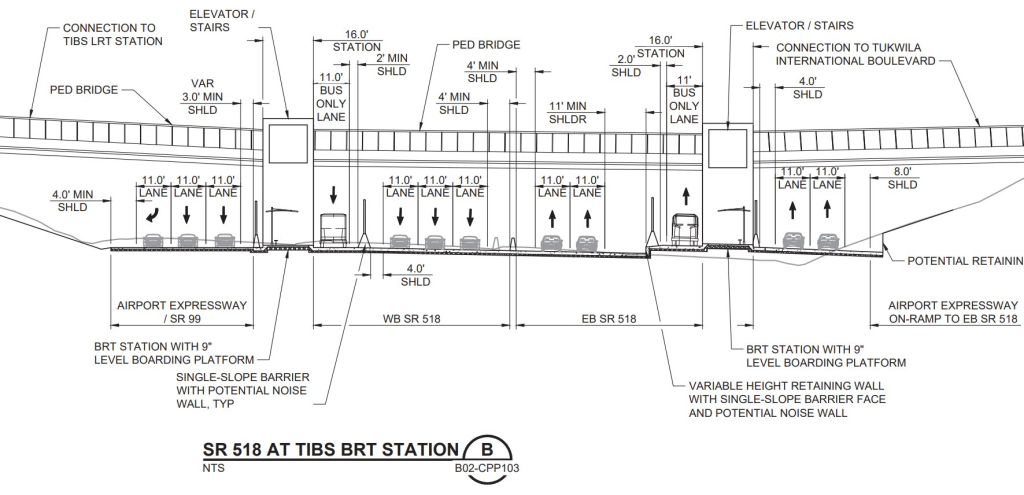
In 2021, Sound Transit looked at potentially cutting costs on the TIBS station by only including pedestrian access from the north, and not including a planned segment of the pedestrian bridge over the SR 518 ramps for anyone arriving from the south. Since then, the agency has signed an agreement with a private developer, Sterling Realty, which owns 25 acres on the south side of SR 518. Sterling will finance the southern leg of the pedestrian bridge that provides direct access to its property, currently home to more auto-dependent uses, but the company envisions turning the site into an “urban village” in the coming years, or decades. So cost-cutting here is off the table.
In its application, Sound Transit cited the highway as a barrier that the coming Stride station will potentially mitigate. “SR518 is a formidable obstacle to pedestrians trying to cross to access the station, or simply access neighborhood locations on either side of the freeway,” it noted. “In April 2022, King County and the Washington State Traffic Safety Commission launched emphasis patrols in the area along Tukwila International Blvd / SR99, citing a rise in car crashes with pedestrians and cyclists. (Tukwila has a Walk Score of 41.)”
But while some pedestrians will be able to take the new pedestrian bridges as an alternative for Tukwila International Boulevard — State Route 99 — directly over the highway, the street remains one of the most dangerous corridors in the state for people walking, with many of the users of transit at TIBS having to use some stretch of the roadway. Nothing Sound Transit is building will truly mitigate that.
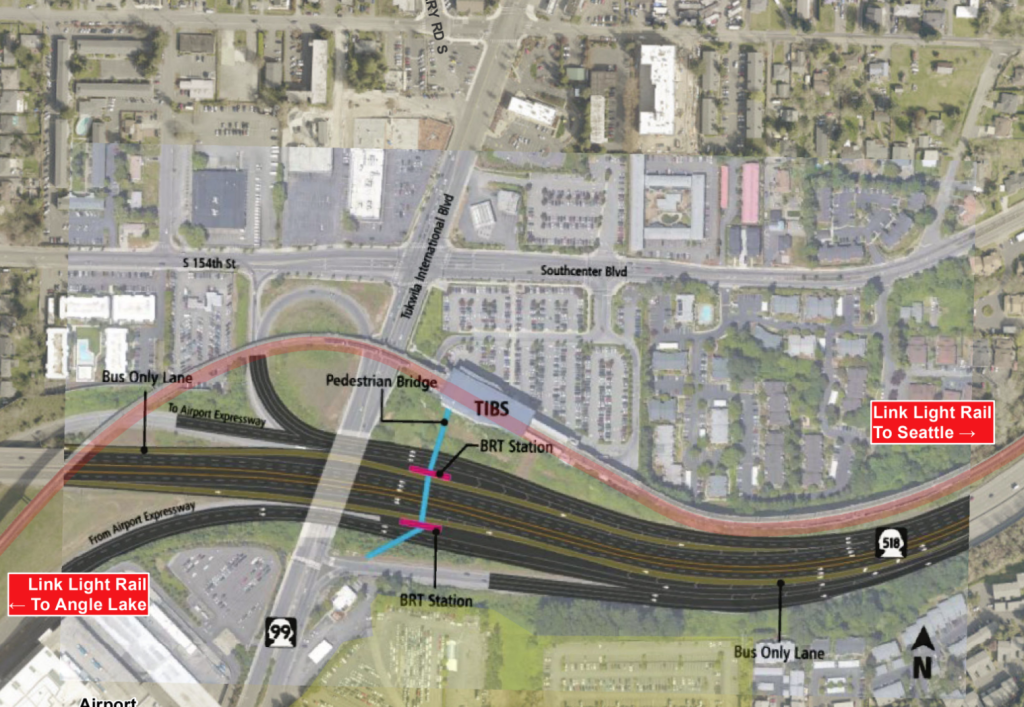
As for the Stride service itself, Sound Transit is touting air quality improvements for the area around its coming stations more generally. “Census tracts surrounding the two stations are in the top 10% of ‘Air Quality Focus Communities’ in the region, characterized by degraded air quality, and are well above the national average,” the grant application states. “The two new BRT stations, with over 5,000 daily boardings, are estimated to improve air quality by providing fast, frequent and reliable transit service.” It touts the all-electric buses planned for Stride, but that ignores the issue that more people will be waiting for transit along the highway, particularly in Tukwila.
The agency projects that 40% of Stride riders will be solo drivers switching to transit, reducing total vehicle miles traveled (VMT) in the area by 16.8 million miles per year just from these two stations. But that assumes that no drivers will take the place of those transit riders on the highways, who won’t be breathing exhaust fumes from buses but will continue to be bombarded with exhaust and particulate matter from the overall road network.
When it comes to spending nearly $70 million in Neighborhood Access and Equity funding for these two projects, it’s hard to even justify calling it a band-aid, consider the depth of underinvestment, traffic deaths, and severe pollution impacts in South King County. Work to actually mitigate and repair impacts from the existing highway system remains unfunded and badly needed.
Ryan Packer has been writing for The Urbanist since 2015, and currently reports full-time as Contributing Editor. Their beats are transportation, land use, public space, traffic safety, and obscure community meetings. Packer has also reported for other regional outlets including BikePortland, Seattle Met, and PubliCola. They live in the Capitol Hill neighborhood of Seattle.

